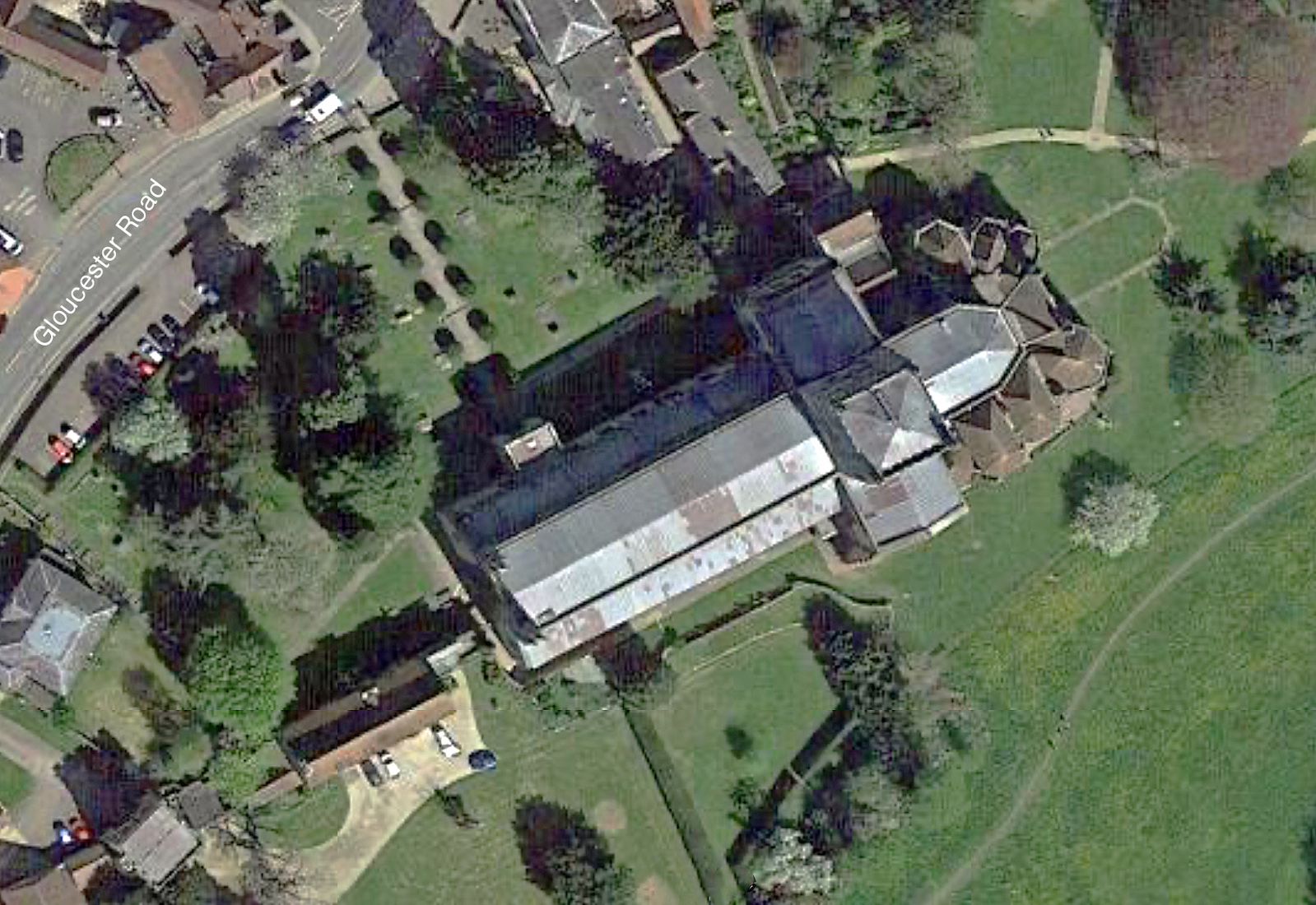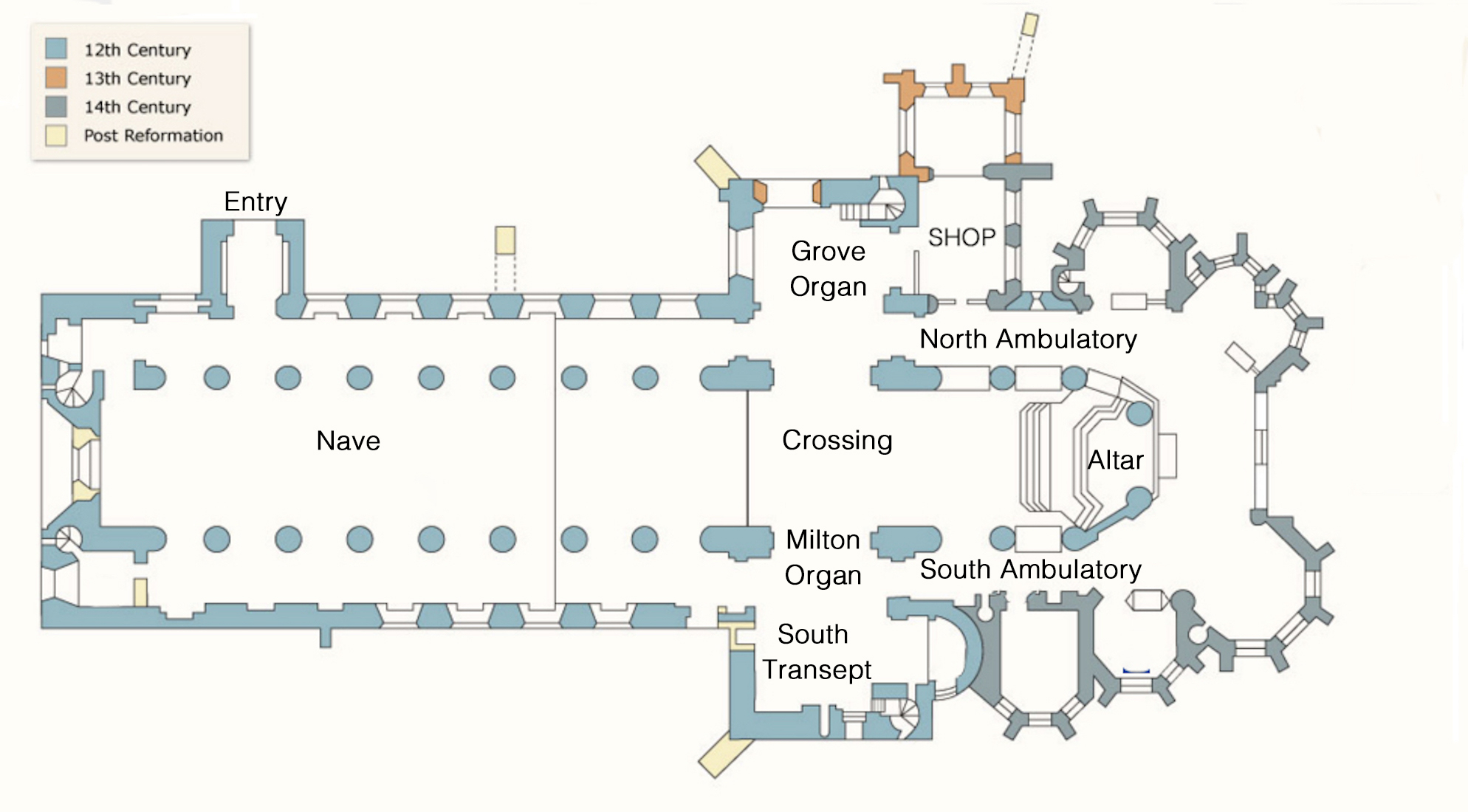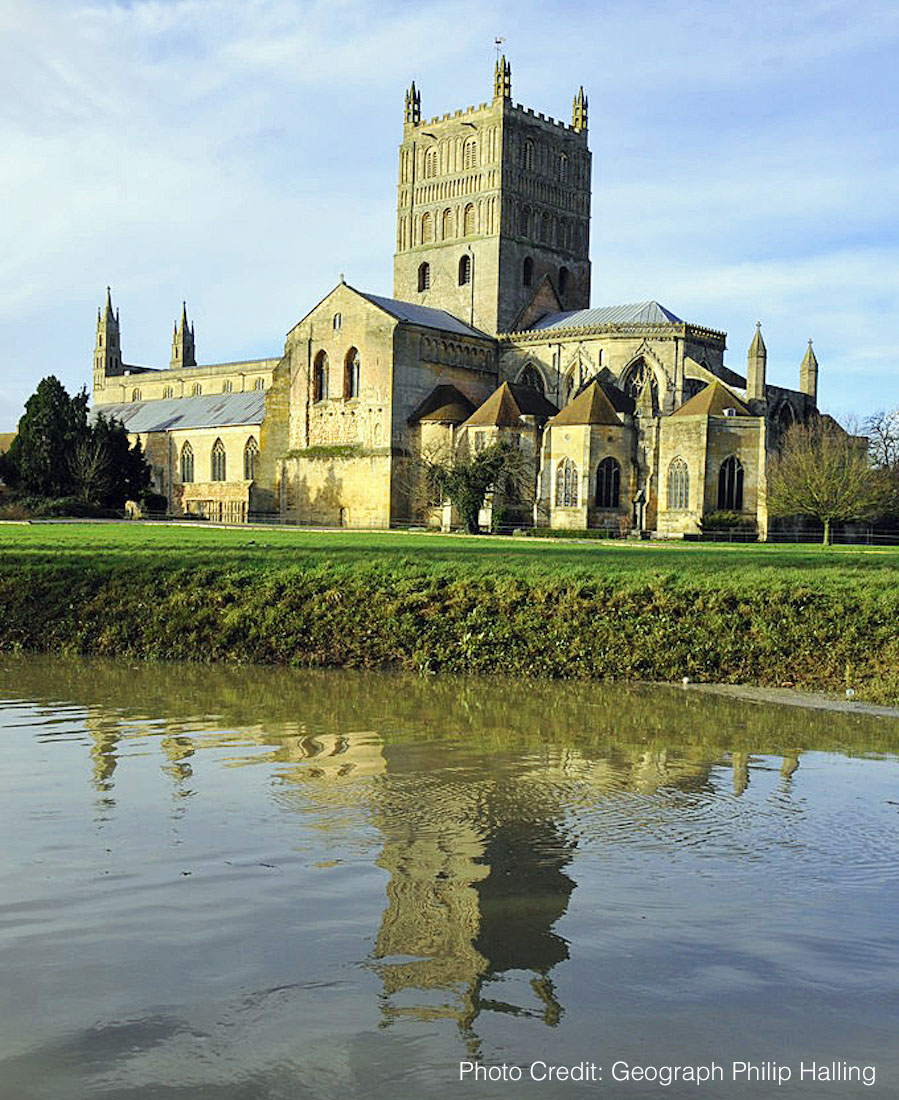It has been fun preparing this website on Tewkesbury Abbey. I have never been to Tewkesbury, but I find that several of my previous website collaborators have, so it has been something of a reunion! There are two main contributors of photographs to this site, but photographs from many others as well, and I am grateful to you all for allowing me to use your photographs here. More information about contributors is given in the Conclusion. Initials at the beginning of each section will indicate who supplied the photograph. Examples are GA for ‘Glass Angel’, and J&J for ‘Jules and Jenny’ who have supplied the superb window photographs. I mention here also Wendy Harris (WH) and Rex Harris (RH). Another set of initials which appears is GSV standing for Google Street View. Google maps in the Street View setting gives a valuable walk-through of the Abbey. Each GSV view is a single image taken from a panoramic view from this walk-through. Less frequent contributors are accredited in the text.
A satellite view, plan, and brief history of this Abbey are given below, and are worth perusing. However, the following set of reference points will allow immediate access to various parts of the Abbey, and will be referenced in the presentation.
SATELLITE VIEW
We shall use liturgical directions on this site using East (with a capital letter) for the direction the sanctuary is pointing in, and other directions accordingly. For the Abbey this is not too far off the geographical orientation, in which the sanctuary / apse is pointing a little north of geographical east.
The satellite view shows that the Abbey has a basic cruciform shape with a square central tower. A separate ‘Abbey House’ lies to the Southwest (bottom left), and there is an entry porch to the Northwest, with a bordered path leading to Gloucester Road. The long nave has a covered aisle on either side, and the Eastern apse is surrounded by chapels. At the Eastern end we can see the foundations of the early Lady Chapel which was destroyed in c1540. The green lawn area to the South slopes down to the River Swilgate with its water meadows.
We shall approach the Abbey from near the Gloucester Road entrance, walking right around the Abbey in a clockwise direction. We return to the Northwest entry to go into the Abbey.


PLAN
The layout of the Abbey is not complex, and a simple plan is shown at left. The plan shows the stages of building of the Abbey.
We shall enter the Abbey by the North door, and explore the nave in an anticlockwise direction, particularly noting the many fine windows. Then to the shop and around the ambulatory from North to South, investigating the various chapels. So to the South transept with the adjoining Lady Chapel, and finishing with the crossing / choir/ sanctuary and altar.
This is an interesting building with a fascinating history, and is a sad reminder of what has been lost through man’s senseless destruction.
HISTORY
Wikipedia
Years Built: mostly12th, 14th Centuries
Address: Gloucester Road, Tewkesbury
The Abbey Church of St Mary the Virgin, Tewkesbury, commonly known as Tewkesbury Abbey, is located in the English county of Gloucestershire. A former Benedictine monastery, it is now a parish church. Considered one of the finest examples of Norman architecture in Britain, it has the largest Romanesque crossing tower in Europe.
Tewkesbury had been a centre for worship since the 7th century. A priory was established there in the 10th century. The present building was started in the early 12th century. It was unsuccessfully used as a sanctuary in the Wars of the Roses. After the dissolution of the monasteries, Tewkesbury Abbey became the parish church for the town. George Gilbert Scott led the restoration of the building in the late 19th century. The church and churchyard within the abbey precincts include tombs and memorials to many of the aristocracy of the area.
Services have been high church but now include Parish Eucharist, choral Mass, and Evensong. These services are accompanied by one of the church’s three organs and choirs. There is a ring of twelve bells, hung for change ringing.
History
The Chronicle of Tewkesbury records that the first Christian worship was brought to the area by Theoc, a missionary from Northumbria, who built his cell in the mid-7th century near a gravel spit where the Severn and Avon rivers join. The cell was succeeded by a monastery in 715, but nothing remaining of it has been identified.
In the 10th century the religious foundation at Tewkesbury became a priory subordinate to the Benedictine Cranborne Abbey in Dorset. In 1087, William the Conqueror gave the manor of Tewkesbury to his cousin, Robert Fitzhamon, who, with Giraldus, Abbot of Cranborne, founded the present abbey in 1092. Building of the present abbey church did not start until 1102, employing Caen stone imported from Normandy and floated up the Severn.
Robert Fitzhamon was wounded at Falaise in Normandy in 1105 and died two years later, but his son-in-law, Robert FitzRoy, the natural son of Henry I who was made Earl of Gloucester, continued to fund the building work. The abbey’s greatest single later patron was Lady Eleanor le Despenser, last of the De Clare heirs of FitzRoy. In the High Middle Ages, Tewkesbury became one of the richest abbeys of England.
After the Battle of Tewkesbury in the Wars of the Roses on 4 May 1471, some of the defeated Lancastrians sought sanctuary in the abbey. The victorious Yorkists, led by King Edward IV, forced their way into the abbey; the resulting bloodshed caused the building to be closed for a month until it could be purified and re-consecrated.
At the dissolution of the monasteries, the last abbot, John Wakeman, surrendered the abbey to the commissioners of King Henry VIII on 9 January 1539. As a former monk of an endowed community, he received an annuity. This was the relatively large sum of 400 marks, but would have ceased when he was ordained as the first Bishop of Gloucester in September 1541. Meanwhile, the people of Tewkesbury saved the abbey from destruction. Insisting that it was their parish church which they had the right to keep, they bought it from the Crown for the value of its bells and lead roof which would have been salvaged and melted down, leaving the structure a roofless ruin. The price came to £453.
The bells merited their own free-standing bell tower, an unusual feature in English sites. After the dissolution, the bell-tower was used as the gaol for the borough until it was demolished in the late 18th century.
The central stone tower was originally topped with a wooden spire, which collapsed in 1559 and was never rebuilt. Restoration undertaken in the late 19th century under Sir George Gilbert Scott was reopened on 23 September 1879. Work continued under the direction of his son John Oldrid Scott until 1910 and included the rood screen of 1892.
Flood waters from the nearby River Severn reached inside the abbey during severe floods in 1760, and again on 23 July 2007.



